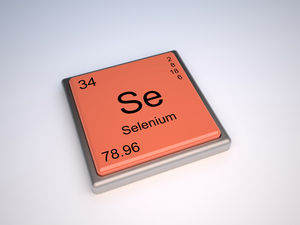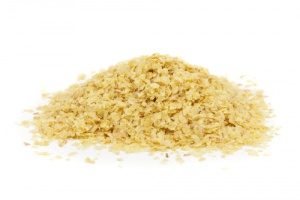Selenium
| See Also | Minerals |
|---|
Selenium is an essential trace element which primarily functions as a component of glutathione peroxidase which is an antioxidant enzyme. Selenium also works together with vitamin E to prevent free-radical damage to cell membranes. Risk of cancer, cardiovascular disease, inflammatory disease, and other conditions which are linked to increases in free-radical damage are all associated with low levels of selenium. Selenium also helps to protect against mercury, cadmium, arsenic, silver, copper, and other heavy metal toxicity [1] [2].
Contents
Food Sources
The following foods have the highest concentration of selenium. For a more expansive list on food sources of specific nutrients visit Health Canada's Dietary Reference Intakes for Elements or USDA's National Nutrient Database
The level of selenium found in food is a direct reflection of the selenium levels found in soil.
- wheat germ, brazil nuts, oats, whole-wheat bread, bran, red swiss chard, brown rice
Other food sources include:[3]
- protein sources: Fish, shellfish, red meat, eggs, chicken, liver
- Other sources include: Brewer's yeast, wheat germ, and enriched breads
Uses
The following is a list of the primary uses for selenium. [1], [2]
- Cancer: The literature supporting the association between low selenium, glutathione peroxidase and increased risk of cancer is plentiful. Adequate selenium levels in terms of its anti-cancer properties appears to be more crucial for men than women and is more protective against respiratory and gastrointestinal tract cancer.
- Immune function: Because selenium plays such a critical role in glutathione peroxidase, this mineral affects all aspects of the immune system. Deficiency in selenium can depress the immune system. Supplementation with selenium stimulates white blood cells and thymus function, even those individuals with adequate levels.
- Cardiovascular Disease (CVD): The antioxidant activity of selenium appears to protect the body from heart disease and stroke. Selenium supplementation has the ability to elevate HDL, the good cholesterol, and it inhibits platelet aggregation. It also appears to protect smokers more than other groups.
- Inflammatory Conditions: Individuals with rheumatoid arthritis, eczema, and psoriasis have low levels of selenium and glutathione peroxidase. Prostaglandins and leukotrienes are responsible for much of the inflammation associated with these conditions and it is glutathione peroxidase's job to reduce this inflammation. Selenium in combination with vitamin E appears to show the most benefit.
- Cataracts: are ultimately the result of free-radical damage and the tissues in the eyes are dependent on glutathione peroxidase and selenium among other enzymes and antioxidants. One study showed that, hydrogen peroxide levels are found to be high and selenium levels are low in the aqueous humour portion of the eyes of those with cataracts. This ultimately leaves the eye vulnerable to free-radical and sun damage and the development of cataracts.
- Pregnancy and SIDS: Evidence shows that selenium is key to proper growth and development of the fetus. Selenium appears to be more crucial during pregnancy and increased intake is needed. Sudden infant death syndrome (SIDS) is also linked to low selenium levels in the newborn. On autopsy, many infants who have passed away from SIDS are found to have focal cardiac necrosis. The theory is is that low selenium and vitamin E make the heart more vulnerable to oxidative damage leading to an area of necrotic tissue in the cardiac muscle.
- Depression: Selenium has been found to have antidepressant properties leading to an elevation in mood and decrease in anxiety. Supplementation proves most beneficial for those eating a diet low in selenium at baseline.
- Skin Conditions: Glutathione peroxidase is found to be low in many individuals with various skin condition such as eczema, atopic dermatitis, psoriasis, and dermatitis herpetiformis.
- Thyroid Function: Selenium is also involved in the conversion of thyroid hormone T4 to its more active form, T3.
- HIV/AIDS: depletes selenium in the body; the greater the depletion, the more likely one is to die from the disease. The prevalence of HIV/AIDS has been found to be lower in parts of the world with higher selenium levels in the soil. Much of the research into this hypothesis - that HIV/AIDS is a nutritional disease caused by a virus which competes with the human body for key components of the glutathione peroxidase enzyme - has been spearheaded by Professor Foster. Preliminary trials are published in "What Really Causes AIDS" [1].
Deficiency Symptoms
Severe selenium deficiency is associated with Keshan Disease. This severe heart condition mainly affects children and women of child-bearing years. It affects people in some areas of China where levels of selenium are low. Kashin-Beck disease is an arthritic condition also associated with selenium deficiency seen in China. Other rare symptoms and conditions associated with severe selenium deficiency include:[2]
More common are the symptoms and conditions associated with chronic low selenium intake and include:[2]
- increased risk of cancer
- heart disease
- low immune function
Excess Symptoms
Selenium has a narrow margin of safety. 800mcg is probably the highest dose that can be taken daily long-term before toxicity may develop.
Higher doses may lead to signs and symptoms such as:
- depression
- nervousness
- emotional instability
- lethargy
- weight loss
- nausea
- vomiting
- garlic-like breath and sweat
- metallic taste in mouth
- digestive irritation
- peripheral neuropathies
- dermatitis
- hair loss
- loss of teeth
- fingernail damage or loss
- rarely thrombocytopenia
- hepato-renal dysfunction
Severe overdose may lead to:
- fever
- increased respiratory rate
- gastrointestinal distress
- paralysis
- myelitis
- in extreme cases, death (although no cases have been reported in humans)
Assessment Procedure
Best specimens to collect:[4]
- RBC - positive result is low
- Hair - positive result is low
Prescribing Considerations
- Organic forms such as selenomethionine and selenium-rich yeast are better absorbed and more biologically active than inorganic salts such as sodium selenite [2].
- The recommended dosages varies based on age and health status. To determine what your specific requirements are talk to your naturopathic doctor or other trained medical professional.[5]
- Infants: 10mcg (under 6 months); 15mcg (6-12 months)
- Child: 20mcg (1-6 years); 30mcg (7-10 months)
- Adolescent: 40mcg (Male 11-14 years); 45mcg (Females 11-14 years); 50mcg (Males and Females 15-18 years)
- Adult: 70mcg (Males 19+ years); 55mcg (Females 19+ years)
- Pregnancy: 65mcg
- Lactation: 75mcg
Safety
- Children: High levels of selenium found in hair samples have been associated with learning disabilities and behavioural problems.
- Contraindications: Low thyroid function or iodine deficiency-induced goiter (increased risk of worsening of symptoms with supplementation); nonmelanoma skin cancer (supplementation may increase risk of squamous cell cancer.
Drug Interactions
- Drug Interactions include:[6]
- Supportive or Beneficial:
- Chemotherapy (Cytotoxic Agents) - Selenium, as part of an antioxidant formulation, appears to reduce adverse effects of chemotherapy in treatment of ovarian cancer.
- Cisplatin - Selenium can reduce nephrotoxicity and adverse effects on white blood cells associated with cisplatin. Co-administer with supervision and monitoring as high selenium levels needed may be toxic. Watch for drug activity interference.
- Doxorubicin and Related Anthracycline Chemotherapy - Selenium may reduce drug-induced cardiotoxicity. Supplementation may be more effective if given before drug exposure.
- Addresses Drug-Induced Deficiency:
- Clozapine - Drug decreases selenium levels and may lead to agranulocytosis, decreased glutathione, and may have effects on the heart. Co-administer selenium at modest levels.
- Corticosteroids, oral - Inflammatory conditions may be associated with low selenium status. Drug may increase urinary selenium and may lower plasma selenium levels. Selenium enhancement can also support immune function reduce oxidative DNA damage.
- Oral Contraceptives - Drug may decrease selenium levels. Supplementation may also reduce risk of hormone-associated cancer.
- Valproic Acid - Drug may decrease selenium levels. Concomitant use may also decrease drug-induced toxic effects. Co-administer especially in children.
Nutrient Interactions
- Nutrient Interactions include: [6]
- S-adenosylmethionine (SAMe) - Toxicity from selenium supplementation is largely due to how it depletes SAMe reserves. SAMe is an important methyl donor and the metabolism of selenium requires extra methyl donors and higher levels of antioxidants.
- Total Parenteral Nutrition (TPN) - Many researchers and clinicians have noted deficiency and depletion of many important nutrients in many receiving TPN. Selenium can prevent adverse effects.
- Vitamin E - Selenium and vitamin E act synergistically and are more effective when taken together.
References
- ↑ 1.0 1.1 1.2 Hoffer Abram, Prousky Jonathan (2006) Naturopathic Nutrition, A Guide to Nutrient-Rich Food & Nutritional Supplements for Optimum Health, CCNM Press
- ↑ 2.0 2.1 2.2 2.3 2.4 Murray Michael T (2005) Encyclopedia of Nutritional Supplements, The Essential Guide for Improving Your Health Naturally, Prima Publishing
- ↑ Medlineplus [1]
- ↑ Bralley J Alexander and Lord Richard S (2005) Laboratory Evaluations in Molecular Medicine, Nutrients, Toxicants, and Cell Regulators Institute for Advances in Molecular Medince, GA
- ↑ tbr
- ↑ 6.0 6.1 Stargrove Mitchell Bebell, Treasure Jonathan, McKee Dwight L (2008) Herb, Nutrient, and Drug Interactions, Clinical Implications and Therapeutic Strategies. Mosby

